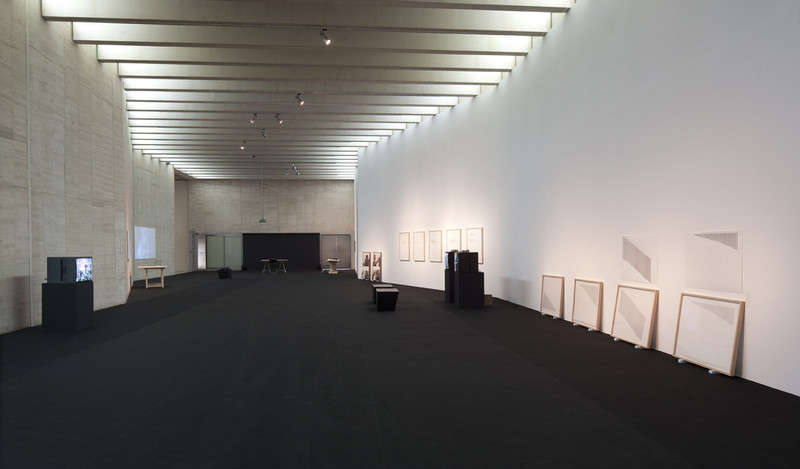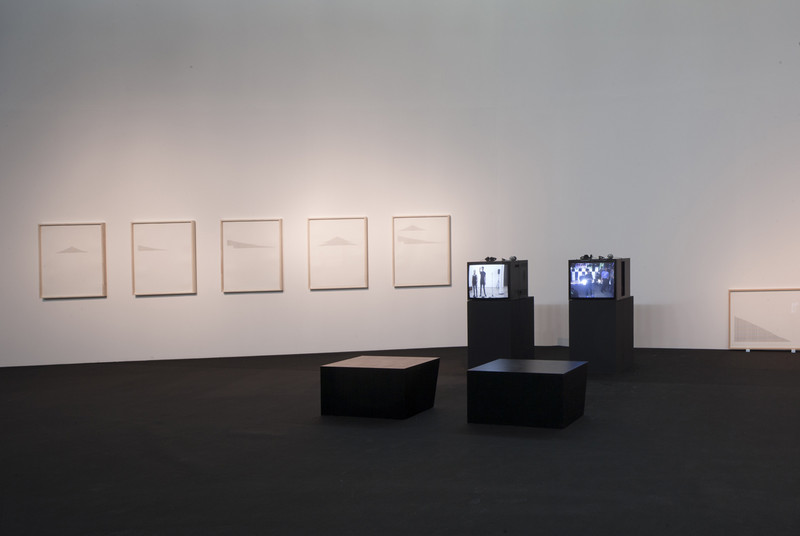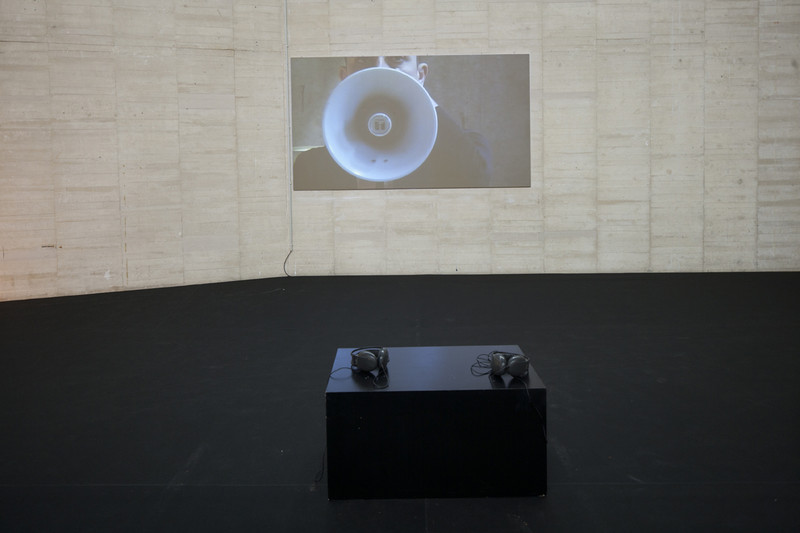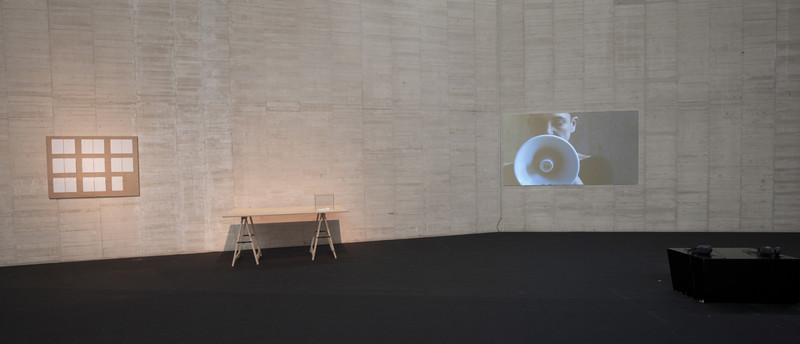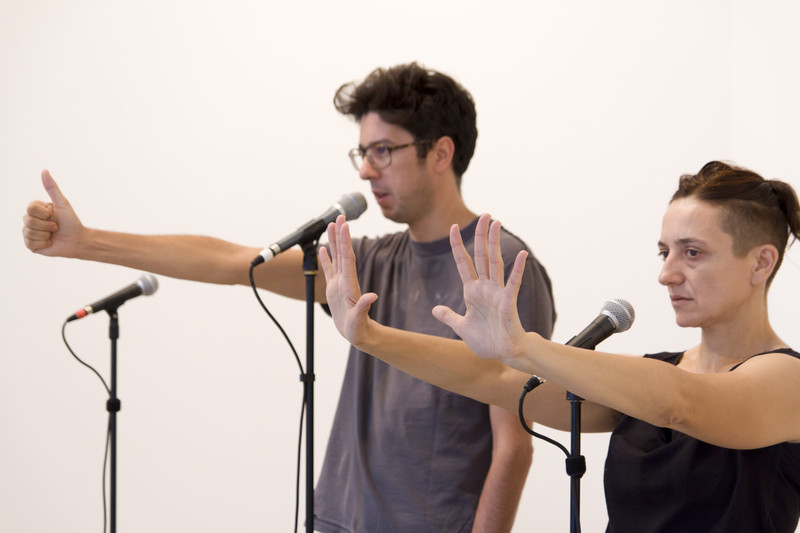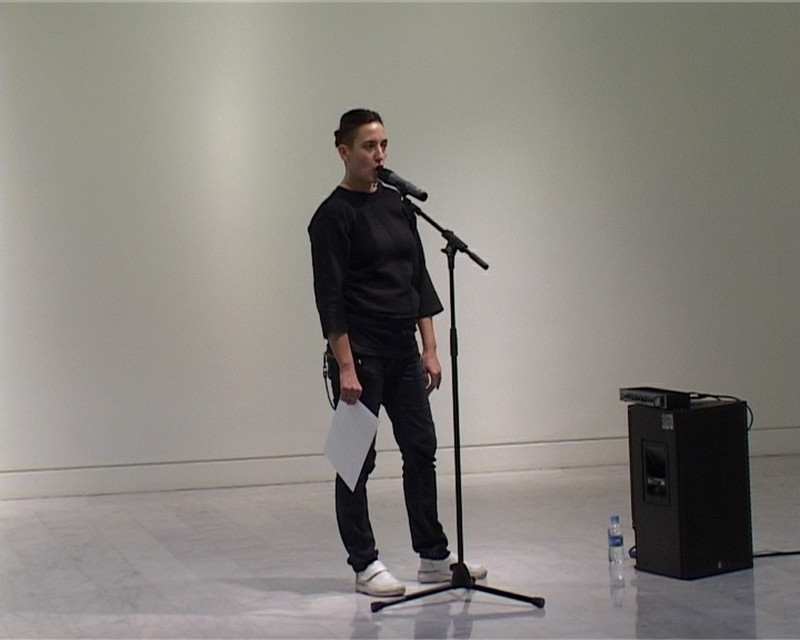Itziar Okariz
22 Jun 2013 - 05 Jan 2014
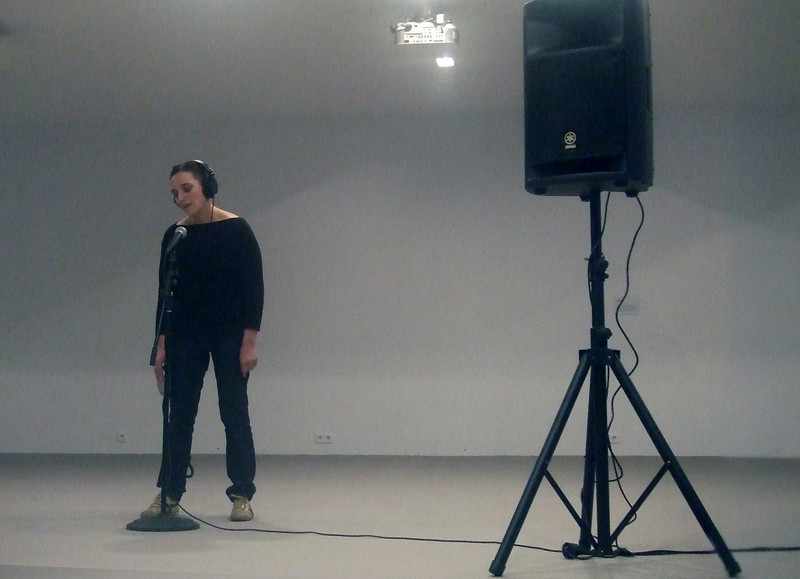
How d 'ye do?, 2010
Performance. Variable length. Approx. 15 min.
© Itziar Okariz. Courtesy of the artist
Performance. Variable length. Approx. 15 min.
© Itziar Okariz. Courtesy of the artist

Costuras de 9 y 7,5 cm de pelo humano
sobre la piel, 1993
Colour photograph. 100 x 70 cm
© Itziar Okariz. Courtesy of the artist
sobre la piel, 1993
Colour photograph. 100 x 70 cm
© Itziar Okariz. Courtesy of the artist
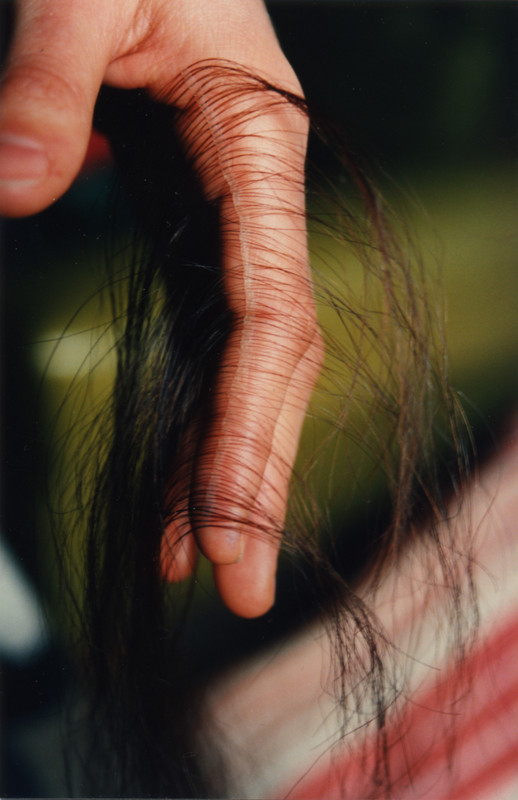
Costuras de 9 y 7,5 cm de pelo humano sobre
la piel, 1993
Colour photograph.100 x 70 cm
© Itziar Okariz. Courtesy of the artist
la piel, 1993
Colour photograph.100 x 70 cm
© Itziar Okariz. Courtesy of the artist
ITZIAR OKARIZ
A Finite Number of Determined Actions
22 June 2013 - 5 January 2014
A Finite Number of Determined Actions is a site-specific project by Itziar Okariz (San Sebastian, 1965) for Exhibition Hall 1 at MUSAC that questions and redefines the boundaries and conventions of performative practice and the possibility of conceiving it within the exhibition space. The project, which opens to the public on Saturday 22 June, is structured around three axes, striving to go beyond the exhibition per se in order to engage the public and the art community in a reflection on the performative exercise as a cultural construct, conceived as a tool for the production of signs, and for the transgression and transformation of codes. The overall project consists of the exhibition itself, the enactment of performances over the duration of the project plus a workshop. Both the performances and the workshops will be held in the exhibition space.
ON ITZIAR OKARIZ’S PRACTICE
Itziar Okariz’s practice embraces performance, video, photography and installation. The artist focuses her interests on the construction of identity and the subversion of existing structures of representation, as well as on the relationships between body and space, both public and private. The immediacy of her actions engages the spaces in which they take place in an ongoing dialogue. The repetition of actions in different places and at different moments is also a core part of her practice, enabling her to underscore nuances and variations with a single basic element.
In recent years Okariz’s work has been exploring the definition of performance and its boundaries. For Okariz it is a differentiated space—on one hand that of theatre, and on the other, a space of action—that offers her a chance to mine the possibilities for communication of gestures and signs culled from our everyday reality. While theatre takes place in a conventional framework of representation grounded in literary narration, performance refutes the limits of those brackets. At once, it is also differentiated from action inasmuch as the emphasis on the performer’s own activity rather than on the results of his/her actions. For this reason it is the negation of the space of representation that defines performance, which, while clearly paradoxical, is charged with a potential for analysing those signs from our everyday lives and how we interact with them.
On the other hand, by centring on the transformation of reality brought about by the artist, for Okariz action would be defined more by the absence or lack of necessity of the public for its enactment. In this regard, Okariz’s work shifts between the two forms of representation: performance and action. In her practice, the artist has adopted the concept of performativity defined by queer theory, ranging from Judith Butler’s insights into the concept of repetition, which she believes is necessarily bound to the identity of the subject, to Eve Kosofsky Sedgwick’s analysis of performativity, which she focused on its power to produce reality. Both these theorists, following the philosopher of language John L. Austin, explore how reality is produced through language. In her performances, Okariz uses those theoretical principles to generate signs and insert them into reality by means of repetition, and in so doing transforming it.
Okariz is interested both in performance in itself and in its derivatives, whether they be documents, records, transcriptions, scripts, etc. In these traces she examines the possibility of fixing ephemeral signs and, by extension, the very legibility and memory of actions and performances. As such, they afford her a chance to analyse the sign in a more specific way, bringing to the fore the difficulty in framing performance within art conventions and classifications, and broaching a reflection on the boundaries between art, document, record, action, etc.
ON A FINITE NUMBER OF DETERMINED ACTIONS
The main idea behind the project is to question and re-define the notion of performance, based on a rethinking of memory and imagination rather than on the documentation of performance itself. The key issues are: How is a memory produced? How is it imagined? Grounded in these questions, the project wishes to examine the conventions that make language intelligible in a certain way. In this regard, given that art is also a construct of language, the intention is to activate the memory with the purpose of ensuring the lastingness of the performative in our minds.
The project is structured around three axes:
Exhibition. In Exhibition Hall 1, the MUSAC will display a selection of works containing a record of performances previously made by Okariz, together with new pieces created specifically for this project. Although the works condense the memory of the performative, they go beyond the mere documentary because they have been specifically conceived and made for their respective formats. Throughout the space are vinyl sound pieces including Aplauso or 30 minutos de adicción and videos such as Irrintzi, How do you do? or π that will be shown next to a series of drawings based on transcriptions of performances such as Uno, uno, dos, uno and Si yo soy yo y tu eres tú, and also a script titled SI – NO made for the publication Cuaderno 1. A Disembodied Voice, Towards Love (Donostia – San Sebastián, Special Issue– Mugatxoan, August 2012).
Performances. With the aim of exploring the project in greater depth and rethinking the notions of memory and imagination, it is also necessary to contrast the works on view in the exhibition space with the actual enactment of the performance itself and the new formats for recording it. Thus, throughout the duration of the project, one weekend each month (Saturday evening and Sunday morning) from June to October (with the exception of August), Itziar Okariz will enact performances open to the public. Some of those performances are previous performances which are now being reformulated, and others will consist of new proposals that will be premiered at the MUSAC, with their recordings and documentation gradually being added to the exhibition.
Workshop. During two weeks in July and September (16-19 July; 24-27 September), the exhibition space will host a workshop open to students, to the art community and to the general public interested in performance. The workshop will implement the premise lending its title to the exhibition, namely, to carry out a finite number of determined actions, starting out from a reflection on the ideas of action and performance. It will consist of the implementation of a number of proposals for actions to be mechanically enacted one after the other, both inside and outside the museum, and with or without an audience. Each proposal will act as the seed for an action. There will be no final goal other than the experience itself.
Both the activities and the subsequent results obtained shall be part of the exhibition, in such a way that anything taking place will be added to it during the various stages of its development. Consequently, the public will have a chance to witness the activity of the artist and of the participants in the workshops.
Okariz invites all participants in the workshop to a process of reflection on performance as a construction, as a specific means for the production of signs and as a tool for their transformation. Thus, individuals taking place will be engaged in creative processes from the initial idea in search of meaning to the quest for its formal configuration.
CALENDAR OF PERFORMANCES
JUNE
Saturday 22 June, 7:30 pm. Gallery 1
Chapter 2, VW. Variable lenght, approx. 40 min.
Sunday 23 June, 1:00 pm. Gallery 1
1121. Variable lenght, approx. 40 min.
JULY
Saturday 20 July, 7:30 pm. Gallery 1
π Variable lenght, approx. 20 min.
Sunday 21 July, 1:00 pm. Gallery 1
Irrintzi Repetition. Variable lenght, approx. 20 min.
SEPTEMBER
Saturday 28 September. 7:30 pm. Gallery 1
Contrariwise. Variable lenght, approx. 20 min.
Sunday 29 September. 1:00 pm. Gallery 1
How D ‘Ye Do? Variable lenght, approx. 20 min.
OCTOBER
Saturday 19 October. 7:30 pm / Sunday 20 October. 1:00 pm. Gallery 1
A Finite Number of Determined Actions. Variable lenght
Curatorship: Agustín Pérez Rubio
Coordination: Helena López Camacho
A Finite Number of Determined Actions
22 June 2013 - 5 January 2014
A Finite Number of Determined Actions is a site-specific project by Itziar Okariz (San Sebastian, 1965) for Exhibition Hall 1 at MUSAC that questions and redefines the boundaries and conventions of performative practice and the possibility of conceiving it within the exhibition space. The project, which opens to the public on Saturday 22 June, is structured around three axes, striving to go beyond the exhibition per se in order to engage the public and the art community in a reflection on the performative exercise as a cultural construct, conceived as a tool for the production of signs, and for the transgression and transformation of codes. The overall project consists of the exhibition itself, the enactment of performances over the duration of the project plus a workshop. Both the performances and the workshops will be held in the exhibition space.
ON ITZIAR OKARIZ’S PRACTICE
Itziar Okariz’s practice embraces performance, video, photography and installation. The artist focuses her interests on the construction of identity and the subversion of existing structures of representation, as well as on the relationships between body and space, both public and private. The immediacy of her actions engages the spaces in which they take place in an ongoing dialogue. The repetition of actions in different places and at different moments is also a core part of her practice, enabling her to underscore nuances and variations with a single basic element.
In recent years Okariz’s work has been exploring the definition of performance and its boundaries. For Okariz it is a differentiated space—on one hand that of theatre, and on the other, a space of action—that offers her a chance to mine the possibilities for communication of gestures and signs culled from our everyday reality. While theatre takes place in a conventional framework of representation grounded in literary narration, performance refutes the limits of those brackets. At once, it is also differentiated from action inasmuch as the emphasis on the performer’s own activity rather than on the results of his/her actions. For this reason it is the negation of the space of representation that defines performance, which, while clearly paradoxical, is charged with a potential for analysing those signs from our everyday lives and how we interact with them.
On the other hand, by centring on the transformation of reality brought about by the artist, for Okariz action would be defined more by the absence or lack of necessity of the public for its enactment. In this regard, Okariz’s work shifts between the two forms of representation: performance and action. In her practice, the artist has adopted the concept of performativity defined by queer theory, ranging from Judith Butler’s insights into the concept of repetition, which she believes is necessarily bound to the identity of the subject, to Eve Kosofsky Sedgwick’s analysis of performativity, which she focused on its power to produce reality. Both these theorists, following the philosopher of language John L. Austin, explore how reality is produced through language. In her performances, Okariz uses those theoretical principles to generate signs and insert them into reality by means of repetition, and in so doing transforming it.
Okariz is interested both in performance in itself and in its derivatives, whether they be documents, records, transcriptions, scripts, etc. In these traces she examines the possibility of fixing ephemeral signs and, by extension, the very legibility and memory of actions and performances. As such, they afford her a chance to analyse the sign in a more specific way, bringing to the fore the difficulty in framing performance within art conventions and classifications, and broaching a reflection on the boundaries between art, document, record, action, etc.
ON A FINITE NUMBER OF DETERMINED ACTIONS
The main idea behind the project is to question and re-define the notion of performance, based on a rethinking of memory and imagination rather than on the documentation of performance itself. The key issues are: How is a memory produced? How is it imagined? Grounded in these questions, the project wishes to examine the conventions that make language intelligible in a certain way. In this regard, given that art is also a construct of language, the intention is to activate the memory with the purpose of ensuring the lastingness of the performative in our minds.
The project is structured around three axes:
Exhibition. In Exhibition Hall 1, the MUSAC will display a selection of works containing a record of performances previously made by Okariz, together with new pieces created specifically for this project. Although the works condense the memory of the performative, they go beyond the mere documentary because they have been specifically conceived and made for their respective formats. Throughout the space are vinyl sound pieces including Aplauso or 30 minutos de adicción and videos such as Irrintzi, How do you do? or π that will be shown next to a series of drawings based on transcriptions of performances such as Uno, uno, dos, uno and Si yo soy yo y tu eres tú, and also a script titled SI – NO made for the publication Cuaderno 1. A Disembodied Voice, Towards Love (Donostia – San Sebastián, Special Issue– Mugatxoan, August 2012).
Performances. With the aim of exploring the project in greater depth and rethinking the notions of memory and imagination, it is also necessary to contrast the works on view in the exhibition space with the actual enactment of the performance itself and the new formats for recording it. Thus, throughout the duration of the project, one weekend each month (Saturday evening and Sunday morning) from June to October (with the exception of August), Itziar Okariz will enact performances open to the public. Some of those performances are previous performances which are now being reformulated, and others will consist of new proposals that will be premiered at the MUSAC, with their recordings and documentation gradually being added to the exhibition.
Workshop. During two weeks in July and September (16-19 July; 24-27 September), the exhibition space will host a workshop open to students, to the art community and to the general public interested in performance. The workshop will implement the premise lending its title to the exhibition, namely, to carry out a finite number of determined actions, starting out from a reflection on the ideas of action and performance. It will consist of the implementation of a number of proposals for actions to be mechanically enacted one after the other, both inside and outside the museum, and with or without an audience. Each proposal will act as the seed for an action. There will be no final goal other than the experience itself.
Both the activities and the subsequent results obtained shall be part of the exhibition, in such a way that anything taking place will be added to it during the various stages of its development. Consequently, the public will have a chance to witness the activity of the artist and of the participants in the workshops.
Okariz invites all participants in the workshop to a process of reflection on performance as a construction, as a specific means for the production of signs and as a tool for their transformation. Thus, individuals taking place will be engaged in creative processes from the initial idea in search of meaning to the quest for its formal configuration.
CALENDAR OF PERFORMANCES
JUNE
Saturday 22 June, 7:30 pm. Gallery 1
Chapter 2, VW. Variable lenght, approx. 40 min.
Sunday 23 June, 1:00 pm. Gallery 1
1121. Variable lenght, approx. 40 min.
JULY
Saturday 20 July, 7:30 pm. Gallery 1
π Variable lenght, approx. 20 min.
Sunday 21 July, 1:00 pm. Gallery 1
Irrintzi Repetition. Variable lenght, approx. 20 min.
SEPTEMBER
Saturday 28 September. 7:30 pm. Gallery 1
Contrariwise. Variable lenght, approx. 20 min.
Sunday 29 September. 1:00 pm. Gallery 1
How D ‘Ye Do? Variable lenght, approx. 20 min.
OCTOBER
Saturday 19 October. 7:30 pm / Sunday 20 October. 1:00 pm. Gallery 1
A Finite Number of Determined Actions. Variable lenght
Curatorship: Agustín Pérez Rubio
Coordination: Helena López Camacho

